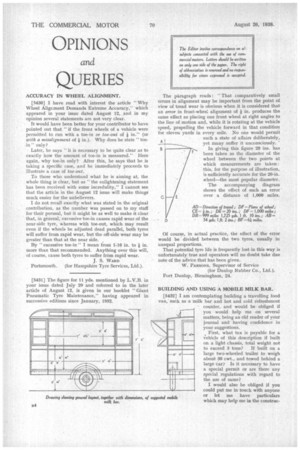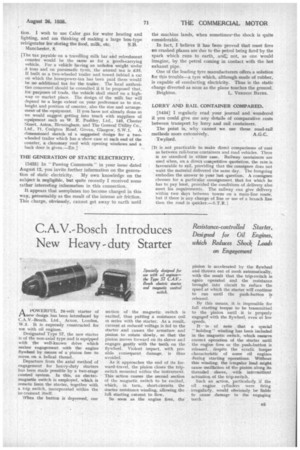OPINIONS
Page 38

Page 39

If you've noticed an error in this article please click here to report it so we can fix it.
and
QUERIES
ACCURACY IN WHEEL ALIGNMENT.
[5430] I have read with interest the article " Why Wheel Alignment Demands Extreme Accuracy," which appeared in your issue dated August 12, and in my opinion several statements are not very clear.
It would have been better for your contributor to have pointed out that " if the front wheels of a vehicle were permitted to run with a toe-in or toe-out of I in." (or with a misalignment of I in.). Why does he state " toee .in " only?
Later, he says "it is necessary to be quite clear as to exactly how the amount of toe-in is measured." Here again, why toe-in only? After this, he says that he is taking a specific case, and he immediately proceeds to illustrate a case of toe-out.
To those who understand what he is aiming at, the whole thing is clear, but as " the enlightening statement has been received with some incredulity," I cannot see that the article in the August 12 issue will make things much easier for the unbelievers.
I do not recall exactly what was stated in the original contribution, as the number was passed on to my staff for their perusal, but it might be as well to make it clear that, in general, excessive toe-in causes rapid wear of the near-side tyre, whereas with toe-out, which may result even if the wheels be adjusted dead parallel, both tyres will suffer from rapid wear, but the off-side wear may be greater than that at the near side.
By "excessive toe-in" I mean from 1-16 in. to .1 in. more than that recommended. Anything over this will, of course, cause both tyres to suffer from rapid wear.
J. S. WARD Portsmouth. (for Hampshire Tyre Services, Ltd.).
[5431] The figure for 11 yds. mentioned by L.V.B. in your issue dated July 29 and referred to in the later article of August 12, is given in our booklet "Giant Pneumatic Tyre Maintenance," having appeared in successive editions since January, 1932. A
The paragraph reads : "That comparatively small errors in alignment may be important from the point of view of tread wear is obvious when it is considered that an error in front-wheel alignment of in. produces the same effect as placing one front wheel at right angles to the line of motion and, while it is rotating at the vehicle speed, propelling the vehicle forward in that condition for eleven yards in every mile. No one would permit such a state of affairs deliberately, yet many suffer it unconsciously. '
In giving this figure 20 ins, has been taken as the diameter of the wheel between the two points at which measurements are taken: this, for the purpose of illustration, is sufficiently accurate for the 20-in. wheel—the most popular diameter.
The accompanying diagram shows the effect of such an error over a distance of 1,000 miles.
Of course, in actual practice, the effect of the error would be divided between the two tyres, usually in unequal proportions.
That potential tyre life is frequently lost in this way is unfortunately true and operators will no doubt take due note of the advice that has been given.
W. PARSONS, Supervisor Of Service (for Dunlop Rubber Co., Ltd.). Fort Dunlop, Birmingham, 24.
BUILDING AND USING, A MOBILE MILK BAR.
[5432] I am contemplating building a travelling food van, such as a milk bar and hot and cold refreshment counter, and would be obliged if you would help me on several matters, being an old reader of your journal and having confidence in your suggestions.
1:
4E—
First, what tax is payable for a vehicle of this description if built on a light chassis, total weight not to exceed 3 tons? If built on a large two-wheeled trailer to weigh about 30 cwt., and towed behind a large ear? Is it necessary to have a special permit or are there any special regulations with regard to the use of same?
I would also be obliged if you could put me in touch with anyone or let me have particulars which may help me in the construe tion. I wish to use Calor gas for water heating and lighting, and am thinking of making a large box-type refrigerator for storing the food, milk, etc. S.B. Manchester, 8.
[The tax payable on a travelling milk bar and refreshment counter would be the same as for a goods-carrying vehicle. For a vehicle having an unladen weight under -3 tons and on pneumatic tyres, the annual tax is £35. If built as a two-wheeled trailer and towed behind a car on which the horsepower-tax has been paid there would be no additional tax for the trailer. The local authorities concerned should be consulted if it be proposed that, for purposes of trade, the vehicle shall stand on a highway or market place. The design of the milk bar will depend to a large extent on your preference WI to size, height and position of counter, also the sire and arrangement of the equipment. If you have not already done so we would suggest getting into touch with suppliers of equipment such as W. R. Pashley, Ltd., 140, Chester Street, Aston. Birmingham, and The General Utility Co., Ltd., 71, Craigton Road, Govan, Glasgow, S.W.1. A dimensioned sketch of a suggested design for a twowheeled trailer which has a show case at each end of the counter, a clerestory roof with opening windows and a back door is given.—En.]
THE GENERATION OF STATIC ELECTRICITY.
154331 In "Passing Comments" in your issue dated August 12, you invite further information on the generation of static electricity. My own knowledge on the subject is negligible, bat quite recently I received some rather interesting information in this connection.
It appears that aeroplanes too become charged in this way, presumably as the result of the intense air friction. This charge, obviously, cannot get away to earth until the machine lands, when sometimes the shock is quite considerable.
In fact, I believe it has been proved that most fires on crashed planes are due to the petrol being fired by the spark which runs to earth, anft not, as one would imagine, by the petrol coming in contact with the hot exhaust pipe.
One of the leading tyre manufacturers offers a solution for this trouble—a tyre which, although made of rubber, is capable of conducting electricity. Thus is the static charge diverted as soon as the plane touches the ground.
Brighton. L. VERNON BATES.
LORRY AND RAIL CONTAINER COMPARED.
[5434] I regularly read your journal and wondered if you could give me any details of comparative costs between transport by lorry and rail containers.
The point is, why cannot we use these road-rail methods more extensively. A.G.C. Twyford.
(It is not practicable to. make direct comparisons of cost as between rail-borne containers and road vehicles. There is no standard in either case. Railway containers are used when, on a direct competitive quotation, the rate is favourable to rail, providing that the consignee does not want the material delivered the same day. The foregoing embodies the answer to your last question. A consignee chooses for a particular consignment that for which he has to pay least, provided the conditions of delivery also meet his requirements. The railway can give delivery within two days between towns on a main-line route, but if there is any change of fine or use of a branch line then the road is quicker.—S.T.R.1




















































































